check engine MITSUBISHI SHOGUN 2016 Owner's Manual (in English)
[x] Cancel search | Manufacturer: MITSUBISHI, Model Year: 2016, Model line: SHOGUN, Model: MITSUBISHI SHOGUN 2016Pages: 404, PDF Size: 18.95 MB
Page 15 of 404
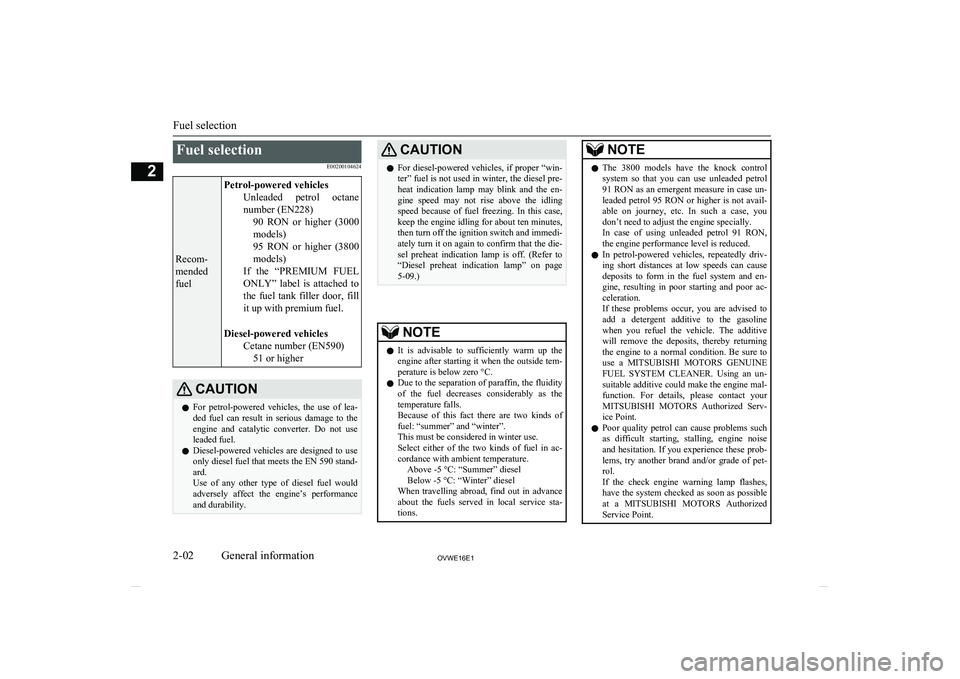
Fuel selectionE00200104624
Recom-
mended
fuel
Petrol-powered vehicles Unleaded petrol octanenumber (EN228) 90 RON or higher (3000
models)
95 RON or higher (3800
models)
If the “PREMIUM FUEL ONLY” label is attached tothe fuel tank filler door, fill
it up with premium fuel.
Diesel-powered vehicles Cetane number (EN590)51 or higherCAUTIONl For petrol-powered vehicles, the use of lea-
ded fuel can result in serious damage to the engine and catalytic converter. Do not use leaded fuel.
l Diesel-powered vehicles are designed to use
only diesel fuel that meets the EN 590 stand-
ard.
Use of any other type of diesel fuel would adversely affect the engine’s performance
and durability.CAUTIONl For diesel-powered vehicles, if proper “win-
ter” fuel is not used in winter, the diesel pre-
heat indication lamp may blink and the en- gine speed may not rise above the idling speed because of fuel freezing. In this case,
keep the engine idling for about ten minutes,
then turn off the ignition switch and immedi- ately turn it on again to confirm that the die-
sel preheat indication lamp is off. (Refer to “Diesel preheat indication lamp” on page
5-09.)
NOTEl It is advisable to sufficiently warm up the
engine after starting it when the outside tem-
perature is below zero °C.
l Due to the separation of paraffin, the fluidity
of the fuel decreases considerably as the
temperature falls.
Because of this fact there are two kinds of
fuel: “summer” and “winter”.
This must be considered in winter use. Select either of the two kinds of fuel in ac- cordance with ambient temperature. Above -5 °C: “Summer” diesel
Below -5 °C: “Winter” diesel
When travelling abroad, find out in advance
about the fuels served in local service sta- tions.NOTEl The 3800 models have the knock control
system so that you can use unleaded petrol
91 RON as an emergent measure in case un-
leaded petrol 95 RON or higher is not avail-
able on journey, etc. In such a case, you don’t need to adjust the engine specially.
In case of using unleaded petrol 91 RON ,
the engine performance level is reduced.
l In petrol-powered vehicles, repeatedly driv-
ing short distances at low speeds can cause
deposits to form in the fuel system and en-
gine, resulting in poor starting and poor ac-
celeration.
If these problems occur, you are advised to add a detergent additive to the gasoline
when you refuel the vehicle. The additive
will remove the deposits, thereby returning the engine to a normal condition. Be sure to use a MITSUBISHI MOTORS GENUINE
FUEL SYSTEM CLEANER. Using an un-
suitable additive could make the engine mal- function. For details, please contact your
MITSUBISHI MOTORS Authorized Serv-
ice Point.
l Poor quality petrol can cause problems such
as difficult starting, stalling, engine noise
and hesitation. If you experience these prob- lems, try another brand and/or grade of pet-
rol.
If the check engine warning lamp flashes,
have the system checked as soon as possible
at a MITSUBISHI MOTORS Authorized
Service Point.
Fuel selection
2-02OVWE16E1General information2
Page 35 of 404

lPressing the LOCK or UNLOCK switch
on the keyless entry switch.
(After pressing the LOCK switch, the
vehicle will lock if all the doors (includ-
ing the backdoor) are closed, after which
the system preparation mode will once again go into effect.)
l Turning the ignition switch to the “ON”
or “ACC” position.NOTEl When the ignition switch is turned to the
“ON” position, the buzzer sounds 4 times.This operation indicates that the alarm was
activated while the vehicle was parked.
Please check the inside of the vehicle to con-
firm that nothing was stolen.
l Even if the battery is disconnected, the alarm
activation memory will not be erased.Electric window control
E00302200185
The electric windows can only be operatedwith the ignition switch in the “ON” position.
Electric window control switch
E00302301226
Each door window opens or closes while the
corresponding switch is operated.
Driver’s switch (LHD)Driver’s switch (RHD)
1- Driver’s door window
2- Front passenger’s door window
3- Rear left door window (5-door models)
4- Rear right door window (5-door models) 5- Lock switch
WARNINGl Before operating the electric window con-
trol, make sure that nothing can get trap-
ped (head, hand, finger, etc.).
l Never leave the vehicle without removing
the key.
l Never leave a child (or other person who
might not be capable of safe operation of
the electric window control) in the vehicle alone.
l The child may tamper with the switch at
the risk of its hands or head being trap- ped in the window.NOTEl Repeated operation with the engine stopped
will run down the battery. Operate the win-
dow switches only while the engine is run- ning.
Driver’s switches
The driver’s switches can be used to operate
all door windows.
A window can be opened or closed by oper- ating the corresponding switch.
Press the switch down to open the window, and pull up the switch to close it.
If the switch for the driver’s window is fully
pressed down/pulled up, the door window au-
tomatically opens/closes completely.
If you want to stop the window movement, operate the switch lightly.
Electric window control
3-16OVWE16E1Locking and unlocking3
Page 39 of 404
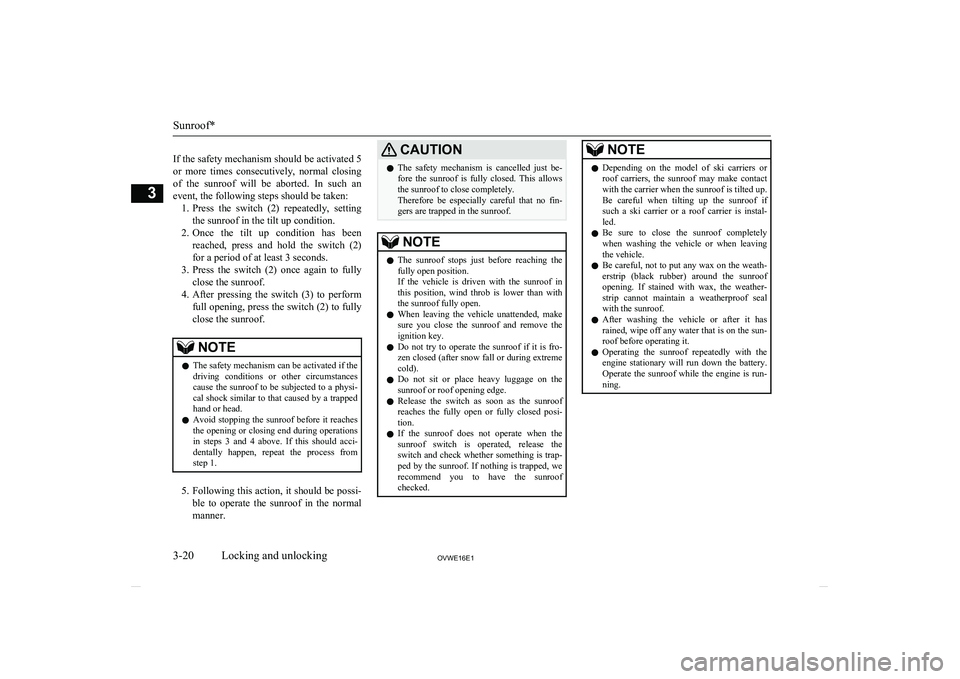
If the safety mechanism should be activated 5 or more times consecutively, normal closing
of the sunroof will be aborted. In such an
event, the following steps should be taken: 1. Press the switch (2) repeatedly, setting
the sunroof in the tilt up condition.
2. Once the tilt up condition has been
reached, press and hold the switch (2)
for a period of at least 3 seconds.
3. Press the switch (2) once again to fully
close the sunroof.
4. After pressing the switch (3) to perform
full opening, press the switch (2) to fully close the sunroof.NOTEl The safety mechanism can be activated if the
driving conditions or other circumstancescause the sunroof to be subjected to a physi-
cal shock similar to that caused by a trapped hand or head.
l Avoid stopping the sunroof before it reaches
the opening or closing end during operations
in steps 3 and 4 above. If this should acci- dentally happen, repeat the process fromstep 1.
5. Following this action, it should be possi-
ble to operate the sunroof in the normal manner.
CAUTIONl The safety mechanism is cancelled just be-
fore the sunroof is fully closed. This allows the sunroof to close completely.
Therefore be especially careful that no fin-
gers are trapped in the sunroof.NOTEl The sunroof stops just before reaching the
fully open position.
If the vehicle is driven with the sunroof in
this position, wind throb is lower than with the sunroof fully open.
l When leaving the vehicle unattended, make
sure you close the sunroof and remove the ignition key.
l Do not try to operate the sunroof if it is fro-
zen closed (after snow fall or during extreme cold).
l Do not sit or place heavy luggage on the
sunroof or roof opening edge.
l Release the switch as soon as the sunroof
reaches the fully open or fully closed posi-
tion.
l If the sunroof does not operate when the
sunroof switch is operated, release the
switch and check whether something is trap-
ped by the sunroof. If nothing is trapped, we recommend you to have the sunroof checked.NOTEl Depending on the model of ski carriers or
roof carriers, the sunroof may make contactwith the carrier when the sunroof is tilted up.Be careful when tilting up the sunroof if
such a ski carrier or a roof carrier is instal-
led.
l Be sure to close the sunroof completely
when washing the vehicle or when leaving the vehicle.
l Be careful, not to put any wax on the weath-
erstrip (black rubber) around the sunroof opening. If stained with wax, the weather- strip cannot maintain a weatherproof seal
with the sunroof.
l After washing the vehicle or after it has
rained, wipe off any water that is on the sun-
roof before operating it.
l Operating the sunroof repeatedly with the
engine stationary will run down the battery. Operate the sunroof while the engine is run-
ning.
Sunroof*
3-20OVWE16E1Locking and unlocking3
Page 97 of 404
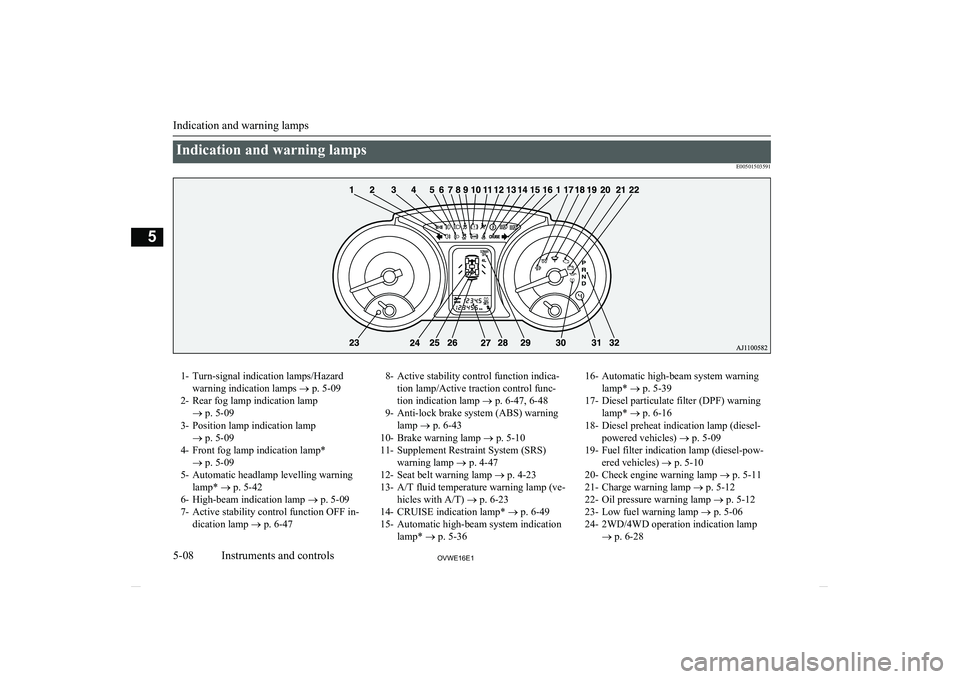
Indication and warning lampsE005015035911- Turn-signal indication lamps/Hazardwarning indication lamps ® p. 5-09
2- Rear fog lamp indication lamp ® p. 5-09
3- Position lamp indication lamp ® p. 5-09
4- Front fog lamp indication lamp* ® p. 5-09
5- Automatic headlamp levelling warning lamp* ® p. 5-42
6- High-beam indication lamp ® p. 5-09
7- Active stability control function OFF in- dication lamp ® p. 6-478- Active stability control function indica-
tion lamp/Active traction control func-
tion indication lamp ® p. 6-47, 6-48
9- Anti-lock brake system (ABS) warning lamp ® p. 6-43
10- Brake warning lamp ® p. 5-10
11- Supplement Restraint System (SRS) warning lamp ® p. 4-47
12- Seat belt warning lamp ® p. 4-23
13- A/T fluid temperature warning lamp (ve- hicles with A/T) ® p. 6-23
14- CRUISE indication lamp* ® p. 6-49
15- Automatic high-beam system indication lamp* ® p. 5-3616- Automatic high-beam system warning
lamp* ® p. 5-39
17- Diesel particulate filter (DPF) warning lamp* ® p. 6-16
18- Diesel preheat indication lamp (diesel- powered vehicles) ® p. 5-09
19- Fuel filter indication lamp (diesel-pow- ered vehicles) ® p. 5-10
20- Check engine warning lamp ® p. 5-11
21- Charge warning lamp ® p. 5-12
22- Oil pressure warning lamp ® p. 5-12
23- Low fuel warning lamp ® p. 5-06
24- 2WD/4WD operation indication lamp ® p. 6-28
Indication and warning lamps
5-08OVWE16E1Instruments and controls5
Page 99 of 404
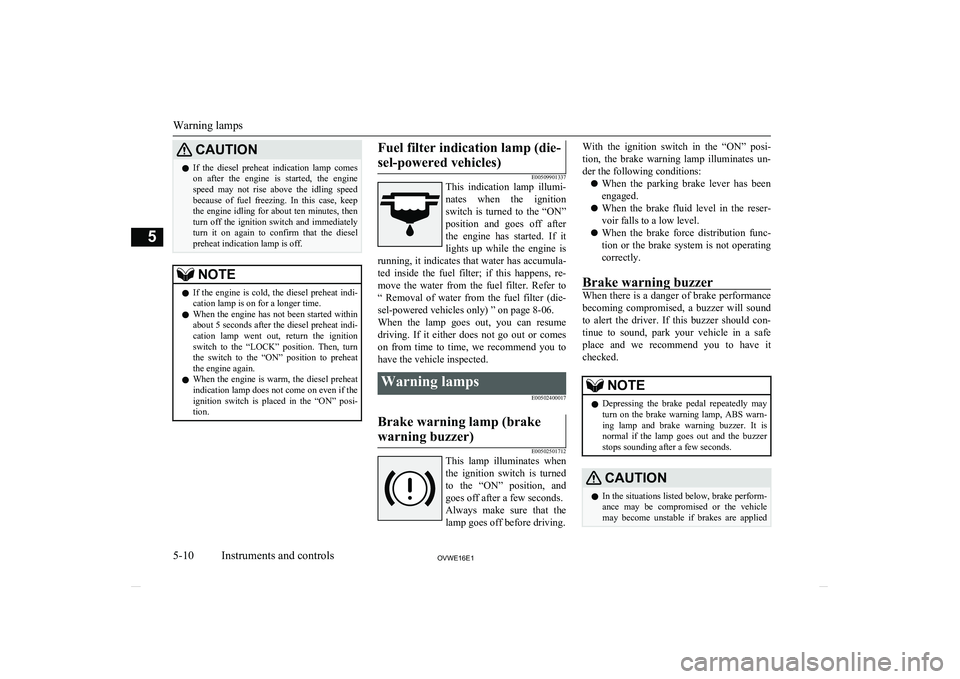
CAUTIONlIf the diesel preheat indication lamp comes
on after the engine is started, the engine speed may not rise above the idling speedbecause of fuel freezing. In this case, keep
the engine idling for about ten minutes, then turn off the ignition switch and immediately
turn it on again to confirm that the diesel
preheat indication lamp is off.NOTEl If the engine is cold, the diesel preheat indi-
cation lamp is on for a longer time.
l When the engine has not been started within
about 5 seconds after the diesel preheat indi- cation lamp went out, return the ignition
switch to the “LOCK” position. Then, turn
the switch to the “ON” position to preheat the engine again.
l When the engine is warm, the diesel preheat
indication lamp does not come on even if the
ignition switch is placed in the “ON” posi-
tion.Fuel filter indication lamp (die-
sel-powered vehicles)
E00509901337
This indication lamp illumi-
nates when the ignition
switch is turned to the “ON” position and goes off after
the engine has started. If it lights up while the engine is
running, it indicates that water has accumula-
ted inside the fuel filter; if this happens, re- move the water from the fuel filter. Refer to
“ Removal of water from the fuel filter (die- sel-powered vehicles only) ” on page 8-06.
When the lamp goes out, you can resume
driving. If it either does not go out or comes on from time to time, we recommend you to
have the vehicle inspected.
Warning lamps
E00502400017Brake warning lamp (brake
warning buzzer)
E00502501712
This lamp illuminates when
the ignition switch is turned to the “ON” position, and goes off after a few seconds.
Always make sure that the
lamp goes off before driving.
With the ignition switch in the “ON” posi-
tion, the brake warning lamp illuminates un- der the following conditions:
l When the parking brake lever has been
engaged.
l When the brake fluid level in the reser-
voir falls to a low level.
l When the brake force distribution func-
tion or the brake system is not operating
correctly.Brake warning buzzer
When there is a danger of brake performance
becoming compromised, a buzzer will sound
to alert the driver. If this buzzer should con-
tinue to sound, park your vehicle in a safe place and we recommend you to have itchecked.
NOTEl Depressing the brake pedal repeatedly may
turn on the brake warning lamp, ABS warn-ing lamp and brake warning buzzer. It is
normal if the lamp goes out and the buzzer stops sounding after a few seconds.CAUTIONl In the situations listed below, brake perform-
ance may be compromised or the vehicle may become unstable if brakes are applied
Warning lamps
5-10OVWE16E1Instruments and controls5
Page 100 of 404
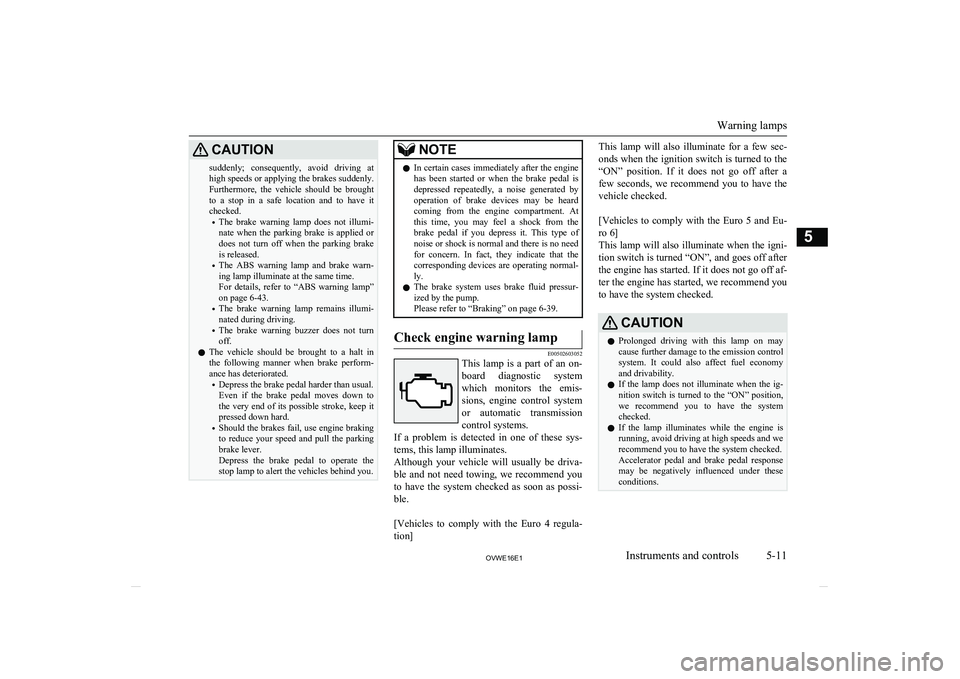
CAUTIONsuddenly; consequently, avoid driving athigh speeds or applying the brakes suddenly.
Furthermore, the vehicle should be brought
to a stop in a safe location and to have it checked.
• The brake warning lamp does not illumi-
nate when the parking brake is applied ordoes not turn off when the parking brake
is released.
• The ABS warning lamp and brake warn-
ing lamp illuminate at the same time.
For details, refer to “ABS warning lamp” on page 6-43.
• The brake warning lamp remains illumi-
nated during driving.
• The brake warning buzzer does not turn
off.
l The vehicle should be brought to a halt in
the following manner when brake perform-
ance has deteriorated.
• Depress the brake pedal harder than usual.
Even if the brake pedal moves down to
the very end of its possible stroke, keep it pressed down hard.
• Should the brakes fail, use engine braking
to reduce your speed and pull the parking
brake lever.
Depress the brake pedal to operate the
stop lamp to alert the vehicles behind you.NOTEl In certain cases immediately after the engine
has been started or when the brake pedal is
depressed repeatedly, a noise generated by operation of brake devices may be heard coming from the engine compartment. At
this time, you may feel a shock from the brake pedal if you depress it. This type of
noise or shock is normal and there is no need for concern. In fact, they indicate that the
corresponding devices are operating normal- ly.
l The brake system uses brake fluid pressur-
ized by the pump.
Please refer to “Braking” on page 6-39.Check engine warning lamp
E00502603052
This lamp is a part of an on-
board diagnostic system
which monitors the emis-
sions, engine control system or automatic transmission
control systems.
If a problem is detected in one of these sys-
tems, this lamp illuminates.
Although your vehicle will usually be driva-
ble and not need towing, we recommend you to have the system checked as soon as possi-
ble.
[Vehicles to comply with the Euro 4 regula-
tion]
This lamp will also illuminate for a few sec-
onds when the ignition switch is turned to the
“ON” position. If it does not go off after a few seconds, we recommend you to have the vehicle checked.
[Vehicles to comply with the Euro 5 and Eu-
ro 6]
This lamp will also illuminate when the igni-
tion switch is turned “ON”, and goes off after the engine has started. If it does not go off af- ter the engine has started, we recommend youto have the system checked.CAUTIONl Prolonged driving with this lamp on may
cause further damage to the emission control system. It could also affect fuel economy
and drivability.
l If the lamp does not illuminate when the ig-
nition switch is turned to the “ON” position,
we recommend you to have the system
checked.
l If the lamp illuminates while the engine is
running, avoid driving at high speeds and we recommend you to have the system checked.
Accelerator pedal and brake pedal response may be negatively influenced under these
conditions.
Warning lamps
5-11OVWE16E1Instruments and controls5
Page 101 of 404
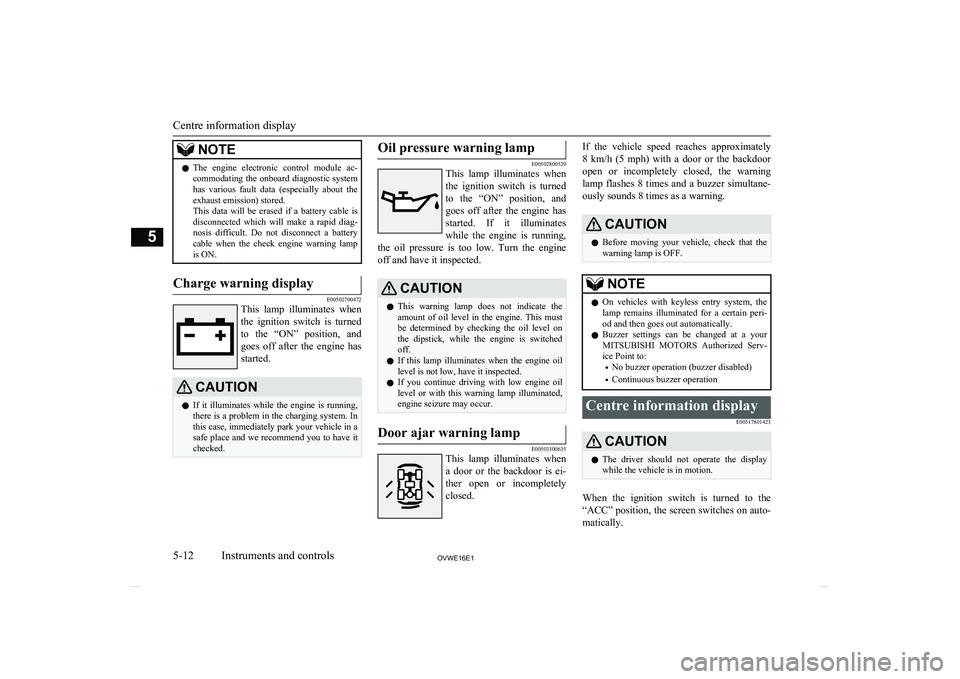
NOTElThe engine electronic control module ac-
commodating the onboard diagnostic system has various fault data (especially about the
exhaust emission) stored.
This data will be erased if a battery cable is
disconnected which will make a rapid diag- nosis difficult. Do not disconnect a batterycable when the check engine warning lamp
is ON.Charge warning display
E00502700472
This lamp illuminates when
the ignition switch is turnedto the “ON” position, and goes off after the engine has
started.
CAUTIONl If it illuminates while the engine is running,
there is a problem in the charging system. In
this case, immediately park your vehicle in a safe place and we recommend you to have it checked.Oil pressure warning lamp
E00502800529
This lamp illuminates when
the ignition switch is turnedto the “ON” position, and goes off after the engine has
started. If it illuminates
while the engine is running,
the oil pressure is too low. Turn the engine off and have it inspected.
CAUTIONl This warning lamp does not indicate the
amount of oil level in the engine. This must
be determined by checking the oil level on the dipstick, while the engine is switched off.
l If this lamp illuminates when the engine oil
level is not low, have it inspected.
l If you continue driving with low engine oil
level or with this warning lamp illuminated,
engine seizure may occur.Door ajar warning lamp
E00503300635
This lamp illuminates when
a door or the backdoor is ei-
ther open or incompletely closed.
If the vehicle speed reaches approximately
8 km/h (5 mph) with a door or the backdoor open or incompletely closed, the warning
lamp flashes 8 times and a buzzer simultane- ously sounds 8 times as a warning.CAUTIONl Before moving your vehicle, check that the
warning lamp is OFF.NOTEl On vehicles with keyless entry system, the
lamp remains illuminated for a certain peri-
od and then goes out automatically.
l Buzzer settings can be changed at a your
MITSUBISHI MOTORS Authorized Serv-
ice Point to:
• No buzzer operation (buzzer disabled)
• Continuous buzzer operationCentre information display
E00517801423CAUTIONlThe driver should not operate the display
while the vehicle is in motion.
When the ignition switch is turned to the
“ACC” position, the screen switches on auto- matically.
Centre information display
5-12OVWE16E1Instruments and controls5
Page 123 of 404
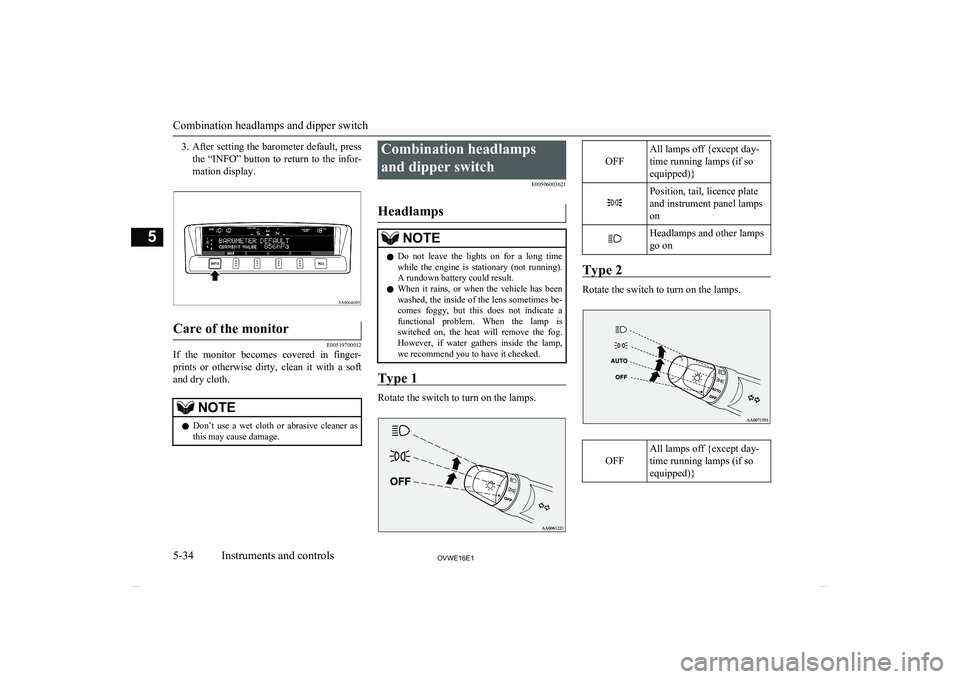
3.After setting the barometer default, press
the “INFO” button to return to the infor-
mation display.Care of the monitor
E00519700012
If the monitor becomes covered in finger-
prints or otherwise dirty, clean it with a soft and dry cloth.
NOTEl Don’t use a wet cloth or abrasive cleaner as
this may cause damage.Combination headlamps
and dipper switch E00506003621
HeadlampsNOTEl Do not leave the lights on for a long time
while the engine is stationary (not running).A rundown battery could result.
l When it rains, or when the vehicle has been
washed, the inside of the lens sometimes be-
comes foggy, but this does not indicate a functional problem. When the lamp is
switched on, the heat will remove the fog. However, if water gathers inside the lamp,
we recommend you to have it checked.
Type 1
Rotate the switch to turn on the lamps.
OFF
All lamps off {except day-
time running lamps (if so
equipped)}Position, tail, licence plate
and instrument panel lamps
onHeadlamps and other lamps
go on
Type 2
Rotate the switch to turn on the lamps.
OFF
All lamps off {except day-
time running lamps (if so
equipped)}
Combination headlamps and dipper switch
5-34OVWE16E1Instruments and controls5
Page 124 of 404
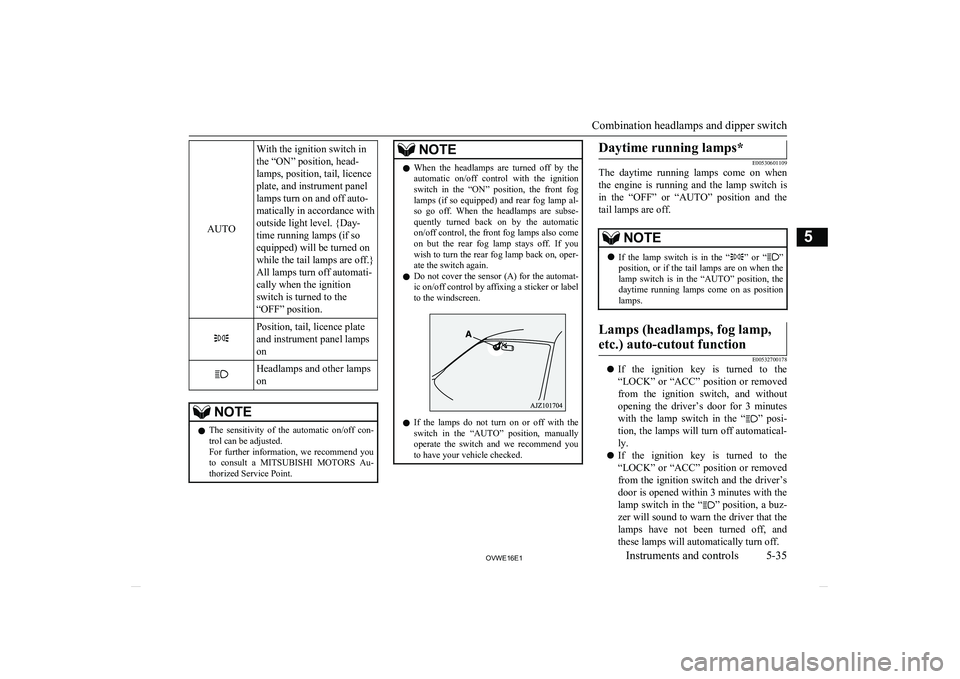
AUTO
With the ignition switch in
the “ON” position, head-
lamps, position, tail, licence
plate, and instrument panel
lamps turn on and off auto-
matically in accordance with
outside light level. {Day-
time running lamps (if so
equipped) will be turned on
while the tail lamps are off.}
All lamps turn off automati-
cally when the ignition
switch is turned to the
“OFF” position.Position, tail, licence plate
and instrument panel lamps
onHeadlamps and other lamps
onNOTEl The sensitivity of the automatic on/off con-
trol can be adjusted.
For further information, we recommend you
to consult a MITSUBISHI MOTORS Au-
thorized Service Point.NOTEl When the headlamps are turned off by the
automatic on/off control with the ignition
switch in the “ON” position, the front fog lamps (if so equipped) and rear fog lamp al-
so go off. When the headlamps are subse- quently turned back on by the automatic
on/off control, the front fog lamps also come on but the rear fog lamp stays off. If you wish to turn the rear fog lamp back on, oper-
ate the switch again.
l Do not cover the sensor (A) for the automat-
ic on/off control by affixing a sticker or label
to the windscreen.
l If the lamps do not turn on or off with the
switch in the “AUTO” position, manually
operate the switch and we recommend you
to have your vehicle checked.
Daytime running lamps*
E00530601109
The daytime running lamps come on when
the engine is running and the lamp switch is in the “OFF” or “AUTO” position and the
tail lamps are off.NOTEl If the lamp switch is in the “” or “”
position, or if the tail lamps are on when the lamp switch is in the “AUTO” position, the
daytime running lamps come on as position lamps.Lamps (headlamps, fog lamp,
etc.) auto-cutout function
E00532700178
l If the ignition key is turned to the
“LOCK” or “ACC” position or removed from the ignition switch, and without
opening the driver’s door for 3 minutes with the lamp switch in the “
” posi-
tion, the lamps will turn off automatical-
ly.
l If the ignition key is turned to the
“LOCK” or “ACC” position or removed from the ignition switch and the driver’s
door is opened within 3 minutes with the
lamp switch in the “
” position, a buz-
zer will sound to warn the driver that the
lamps have not been turned off, and these lamps will automatically turn off.
Combination headlamps and dipper switch
5-35OVWE16E1Instruments and controls5
Page 141 of 404
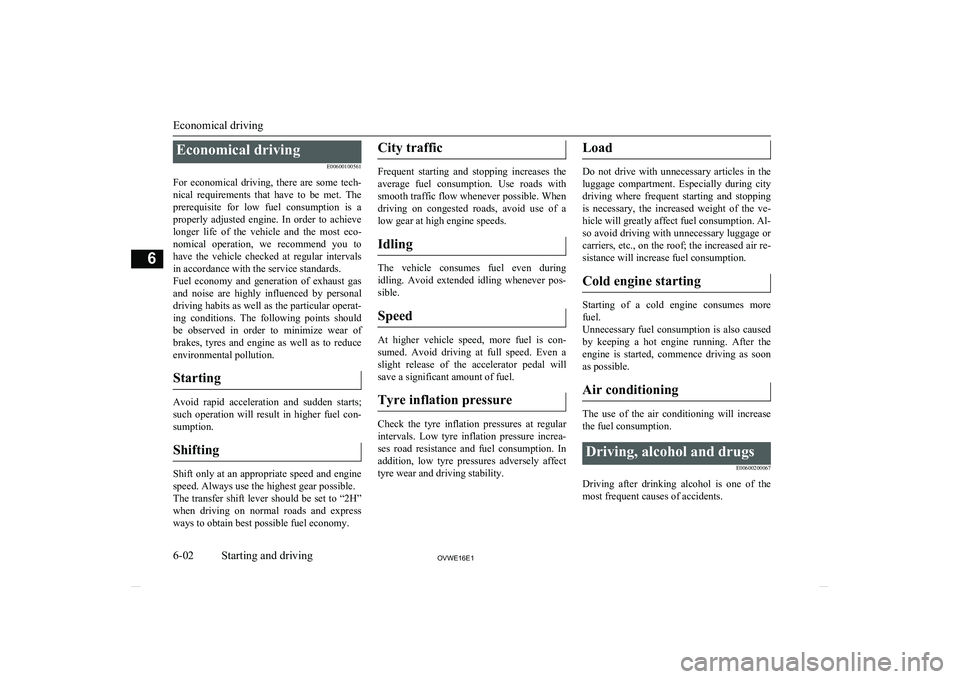
Economical drivingE00600100561
For economical driving, there are some tech- nical requirements that have to be met. Theprerequisite for low fuel consumption is a
properly adjusted engine. In order to achieve longer life of the vehicle and the most eco- nomical operation, we recommend you tohave the vehicle checked at regular intervals in accordance with the service standards.
Fuel economy and generation of exhaust gas
and noise are highly influenced by personal
driving habits as well as the particular operat- ing conditions. The following points shouldbe observed in order to minimize wear of
brakes, tyres and engine as well as to reduce
environmental pollution.
Starting
Avoid rapid acceleration and sudden starts;
such operation will result in higher fuel con-
sumption.
Shifting
Shift only at an appropriate speed and engine speed. Always use the highest gear possible.
The transfer shift lever should be set to “2H” when driving on normal roads and express
ways to obtain best possible fuel economy.
City traffic
Frequent starting and stopping increases the
average fuel consumption. Use roads with smooth traffic flow whenever possible. When driving on congested roads, avoid use of a
low gear at high engine speeds.
Idling
The vehicle consumes fuel even during
idling. Avoid extended idling whenever pos- sible.
Speed
At higher vehicle speed, more fuel is con-
sumed. Avoid driving at full speed. Even a
slight release of the accelerator pedal will save a significant amount of fuel.
Tyre inflation pressure
Check the tyre inflation pressures at regularintervals. Low tyre inflation pressure increa-ses road resistance and fuel consumption. In addition, low tyre pressures adversely affect
tyre wear and driving stability.
Load
Do not drive with unnecessary articles in the
luggage compartment. Especially during city
driving where frequent starting and stopping is necessary, the increased weight of the ve-
hicle will greatly affect fuel consumption. Al- so avoid driving with unnecessary luggage or carriers, etc., on the roof; the increased air re- sistance will increase fuel consumption.
Cold engine starting
Starting of a cold engine consumes more fuel.
Unnecessary fuel consumption is also caused by keeping a hot engine running. After the
engine is started, commence driving as soon
as possible.
Air conditioning
The use of the air conditioning will increase the fuel consumption.
Driving, alcohol and drugs
E00600200067
Driving after drinking alcohol is one of the
most frequent causes of accidents.
Economical driving
6-02OVWE16E1Starting and driving6